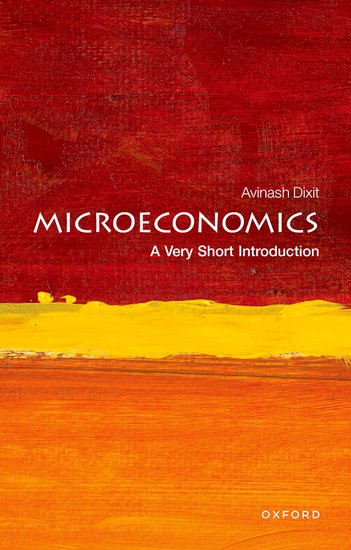Home >
A Very Short Introduction >
Microeconomics (Business & Economics)
A Very Short Introduction | Business & Economics
Microeconomics
ISBN: 9780199689378
Series: A Very Short Introduction
Microeconomics (Business & Economics)
A Very Short Introduction Microeconomics (Business & Economics) Media > Books > Non-Fiction > Education Books Expect Delays of Up to 4 Weeks| Order Below |
ISBN
9780199689378 (10-digit ISBN: 0199689377)
- Description
- Key Features
- Series Description
- Table of Contents
- Clearly explains what microeconomics is and how it works
- Illustrates the concepts of microeconomics through examples in politics, government, and everyday life
- Addresses the failures of the microeconomy and what can be done to address them
Microeconomics - individuals' choices of where to live and work, how much to save, what to buy, and firms' decisions about location, hiring, firing, and investment - involves issues that concern us on a daily basis. But when people think about economics, they tend to place importance on the bigger picture - macroeconomics - including issues such as unemployment, inflation, and the competitiveness of nations.
In this Very Short Introduction, Avinash Dixit argues that the microeconomy has a large impact on the economic world, arguably as much as the issues of macroeconomics.
Dixit steers a clear path through the huge number of issues related to microeconomics, explaining what happens when things go well, as well as showing how they fail, why that happens, and what can be done about it. Using real-life examples from around the world, using the minimum of mathematics and including simple graphs, he provides insights into economics from psychology and sociology to explain economic behaviour and rational choice. An ideal introduction for anyone interested in business and economics.
Reading Guide
Oxford's Very Short Introductions series offers concise and original introductions to a wide range of subjects--from Islam to Sociology, Politics to Classics, Literary Theory to History, and Archaeology to the Bible.
Not simply a textbook of definitions, each volume in this series provides trenchant and provocative--yet always balanced and complete--discussions of the central issues in a given discipline or field. Every Very Short Introduction gives a readable evolution of the subject in question, demonstrating how the subject has developed and how it has influenced society. Eventually, the series will encompass every major academic discipline, offering all students an accessible and abundant reference library.
Whatever the area of study that one deems important or appealing, whatever the topic that fascinates the general reader, the Very Short Introductions series has a handy and affordable guide that will likely prove indispensable.
Please note: As this series is not ELT material, these titles are not subject to discount.
1: What and why of microeconomics
2: Consumers
3: Producers
4: Markets and incentives
5: Institutions and organizations
6: Policy
Further reading
Microeconomics - individuals' choices of where to live and work, how much to save, what to buy, and firms' decisions about location, hiring, firing, and investment - involves issues that concern us on a daily basis. But when people think about economics, they tend to place importance on the bigger picture - macroeconomics - including issues such as unemployment, inflation, and the competitiveness of nations.
In this Very Short Introduction, Avinash Dixit argues that the microeconomy has a large impact on the economic world, arguably as much as the issues of macroeconomics.
Dixit steers a clear path through the huge number of issues related to microeconomics, explaining what happens when things go well, as well as showing how they fail, why that happens, and what can be done about it. Using real-life examples from around the world, using the minimum of mathematics and including simple graphs, he provides insights into economics from psychology and sociology to explain economic behaviour and rational choice. An ideal introduction for anyone interested in business and economics.
Reading Guide
Key Features
- Clearly explains what microeconomics is and how it works
- Illustrates the concepts of microeconomics through examples in politics, government, and everyday life
- Addresses the failures of the microeconomy and what can be done to address them
Series Description
Oxford's Very Short Introductions series offers concise and original introductions to a wide range of subjects--from Islam to Sociology, Politics to Classics, Literary Theory to History, and Archaeology to the Bible.
Not simply a textbook of definitions, each volume in this series provides trenchant and provocative--yet always balanced and complete--discussions of the central issues in a given discipline or field. Every Very Short Introduction gives a readable evolution of the subject in question, demonstrating how the subject has developed and how it has influenced society. Eventually, the series will encompass every major academic discipline, offering all students an accessible and abundant reference library.
Whatever the area of study that one deems important or appealing, whatever the topic that fascinates the general reader, the Very Short Introductions series has a handy and affordable guide that will likely prove indispensable.
Please note: As this series is not ELT material, these titles are not subject to discount.
EASY ORDER FORM
PRICES LISTED INCLUDE CONSUMPTION TAX
Price Before Tax:
¥1,790


